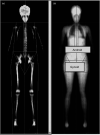Association of regional body fat with metabolic risks in Chinese women
- PMID: 24148901
- PMCID: PMC10282636
- DOI: 10.1017/S1368980013002668
Association of regional body fat with metabolic risks in Chinese women
Abstract
Objective: To investigate the association of regional fat depots with metabolic risk factors in Chinese women.
Design: Total and regional fat depots including android fat and gynoid fat were measured by dual-energy X-ray absorptiometry. Central fat distribution was defined as android:gynoid fat ratio. Metabolic risk factors were defined as elevated TAG, reduced HDL-cholesterol, elevated blood pressure and elevated fasting plasma glucose. Logistic regression analyses were performed to examine the associations of regional fat depots with metabolic risk factors. The odds ratios of metabolic risks were further calculated according to tertiles of android fat and gynoid fat.
Setting: Participants were recruited from a community-based cross-sectional study. Face-to-face questionnaires, anthropometric and dual-energy X-ray absorptiometry measures were conducted.
Subjects: Chinese women (n 609) aged 18-79 years.
Results: Android fat and android:gynoid fat ratio were associated with significantly increased odds (OR = 1·4-3·7; P < 0·01) for almost all risk factors, whereas gynoid fat was independently associated with significantly decreased odds (OR = 0·3-0·6; P < 0·01). The inverse associations of gynoid fat with metabolic risk factors remained after adjusting for android fat. Even if their android fat level was in high, women in the highest tertile of gynoid fat had lower odds of having at least two metabolic risk factors compared with women in the lowest gynoid fat tertile (P for trend < 0·01).
Conclusions: There were opposite associations of android and gynoid fat with metabolic risks in Chinese women. Gynoid fat rather than android fat might be a more important inclusion in metabolic disease risk evaluation in female Asians.
Figures


Similar articles
-
Sex differences in the associations between adiposity distribution and cardiometabolic risk factors in overweight or obese individuals: a cross-sectional study.BMC Public Health. 2021 Jun 26;21(1):1232. doi: 10.1186/s12889-021-11316-4. BMC Public Health. 2021. PMID: 34174845 Free PMC article.
-
Contribution of Android and Gynoid Adiposity to Bone Mineral Density in Healthy Postmenopausal Thai Women.J Clin Densitom. 2019 Jul-Sep;22(3):346-350. doi: 10.1016/j.jocd.2018.05.037. Epub 2018 May 28. J Clin Densitom. 2019. PMID: 30064814
-
Central fat accumulation associated with metabolic risks beyond total fat in normal BMI Chinese adults.Ann Nutr Metab. 2014;64(2):93-100. doi: 10.1159/000363072. Epub 2014 Jun 14. Ann Nutr Metab. 2014. PMID: 24943409
-
Adiposity assessed by anthropometric measures has a similar or greater predictive ability than dual-energy X-ray absorptiometry measures for abdominal aortic calcification in community-dwelling older adults.Int J Cardiovasc Imaging. 2016 Sep;32(9):1451-1460. doi: 10.1007/s10554-016-0920-2. Epub 2016 May 31. Int J Cardiovasc Imaging. 2016. PMID: 27246927
-
Adipose tissue deposition region affects fall risk in people with obesity: A systematic review and meta-analysis.Obes Res Clin Pract. 2024 Jan-Feb;18(1):1-8. doi: 10.1016/j.orcp.2024.02.003. Epub 2024 Feb 15. Obes Res Clin Pract. 2024. PMID: 38360492
Cited by
-
Systematic metabolomic studies identified adult adiposity biomarkers with acetylglycine associated with fat loss in vivo.Front Mol Biosci. 2023 Apr 14;10:1166333. doi: 10.3389/fmolb.2023.1166333. eCollection 2023. Front Mol Biosci. 2023. PMID: 37122566 Free PMC article.
-
Abdominal Adiposity and Total Body Fat as Predictors of Cardiometabolic Health in Children and Adolescents With Obesity.Front Endocrinol (Lausanne). 2020 Sep 4;11:579. doi: 10.3389/fendo.2020.00579. eCollection 2020. Front Endocrinol (Lausanne). 2020. PMID: 33013688 Free PMC article.
-
Association of the android to gynoid fat ratio with nonalcoholic fatty liver disease: a cross-sectional study.Front Nutr. 2023 May 15;10:1162079. doi: 10.3389/fnut.2023.1162079. eCollection 2023. Front Nutr. 2023. PMID: 37255941 Free PMC article.
-
Metabolically Healthy Obesity-Heterogeneity in Definitions and Unconventional Factors.Metabolites. 2020 Jan 27;10(2):48. doi: 10.3390/metabo10020048. Metabolites. 2020. PMID: 32012784 Free PMC article. Review.
-
Commingling effect of gynoid and android fat patterns on cardiometabolic dysregulation in normal weight American adults.Nutr Diabetes. 2015 May 18;5(5):e155. doi: 10.1038/nutd.2015.5. Nutr Diabetes. 2015. PMID: 25985091 Free PMC article.
References
-
- Grundy SM (2004) Obesity, metabolic syndrome, and cardiovascular disease. J Clin Endocrinol Metab 89, 2595–2600. - PubMed
-
- World Health Organization (2000) Obesity: Preventing and Managing the Global Epidemic. Report of a WHO Consultation. WHO Technical Report Series no. 894. Geneva: WHO. - PubMed
-
- Zhang C, Rexrode KM, van Dam RM et al. (2008) Abdominal obesity and the risk of all-cause, cardiovascular, and cancer mortality: sixteen years of follow-up in US women. Circulation 117, 1658–1667. - PubMed
-
- Snijder MB, van Dam RM, Visser M et al. (2006) What aspects of body fat are particularly hazardous and how do we measure them? Int J Epidemiol 35, 83–92. - PubMed
Publication types
MeSH terms
LinkOut - more resources
Full Text Sources
Other Literature Sources
Medical

